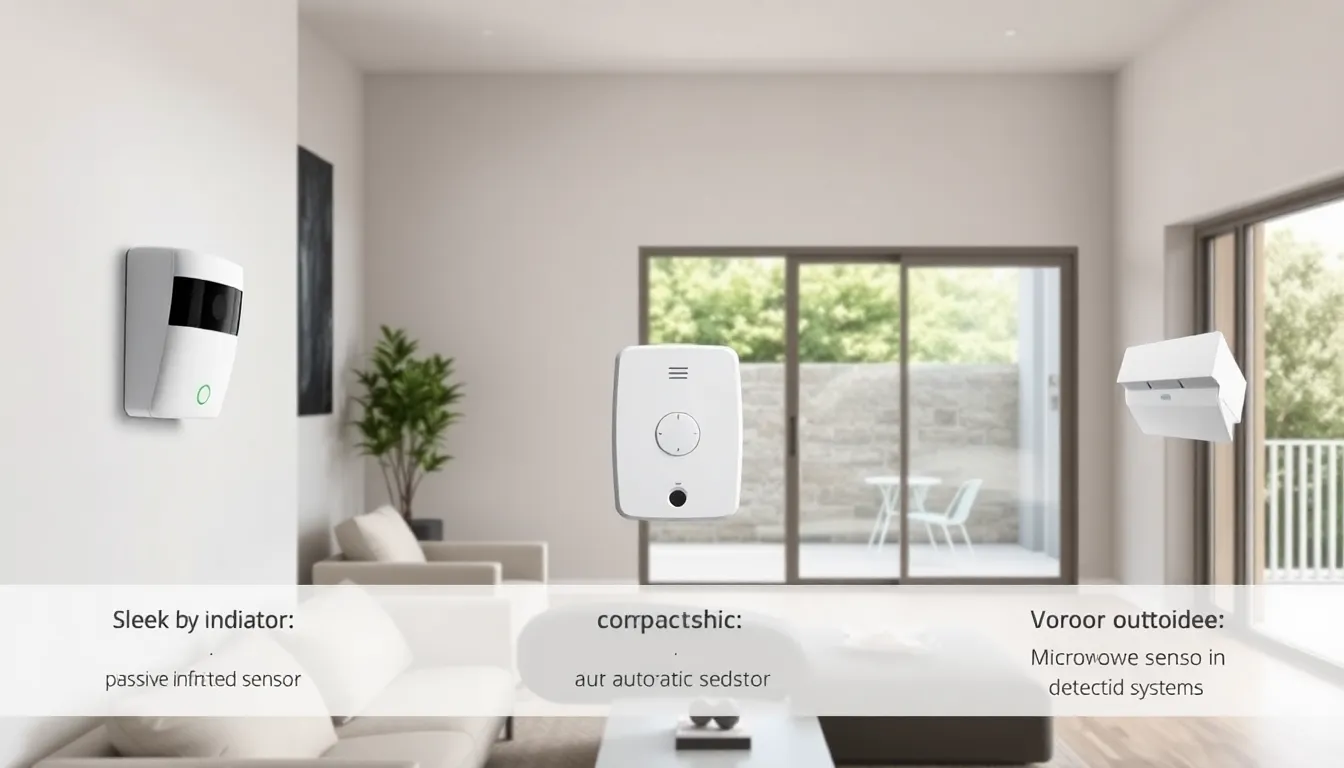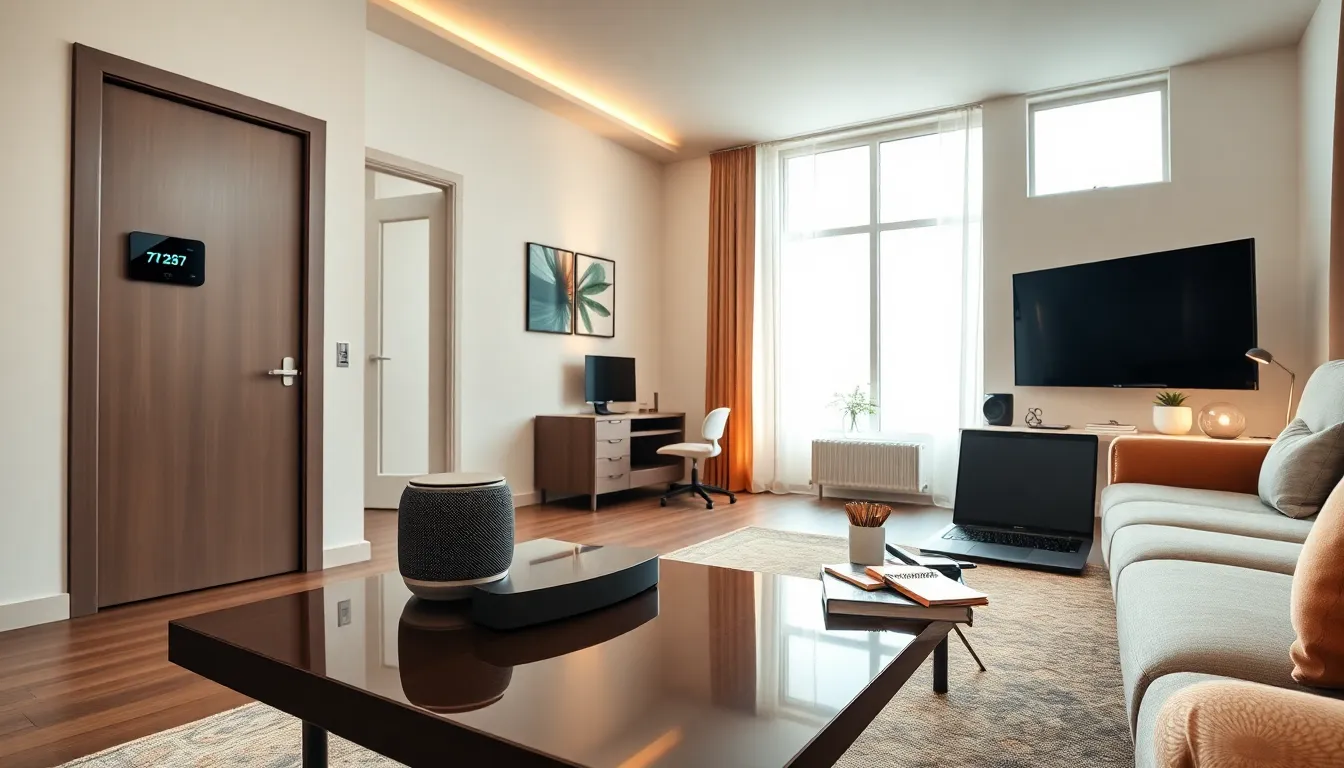In a world where every second counts, motion sensor devices are the unsung heroes making life a little easier—and a whole lot smarter. Imagine walking into a room and having the lights flicker on like a personal spotlight just for you. No more fumbling for switches in the dark. These nifty gadgets not only save energy but also add a sprinkle of convenience to daily routines.
Table of Contents
ToggleOverview of Motion Sensor Devices
Motion sensor devices detect movement within a designated area. These devices employ various technologies, including passive infrared sensors, microwave sensors, and dual-technology sensors. Passive infrared sensors monitor changes in heat, while microwave sensors emit microwave signals to identify motion. Dual-technology sensors combine both methods for increased accuracy.
Applications range widely, from residential settings to commercial spaces. In homes, they control lighting systems, security alarms, and automated blinds. Many businesses utilize motion sensors to enhance security measures and improve energy efficiency by managing lighting and HVAC systems.
Installation options vary, offering flexibility for different environments. Wall-mounted sensors suit hallways and entrances, while ceiling-mounted versions are ideal for larger rooms. Wireless models provide convenient installation without the need for extensive wiring.
The benefits of motion sensor devices extend beyond convenience. Energy savings represent a significant advantage, as lights turn off automatically when a room is unoccupied. In commercial spaces, this can lead to reduced energy costs, contributing to a sustainable environment.
User-friendly interfaces simplify operation. Many devices feature adjustable sensitivity settings, allowing users to customize them according to their specific needs. The integration of smart home technology also enhances usability, with remote access and monitoring available through smartphone apps.
As lighting technology evolves, energy-efficient LED options grow increasingly popular. Motion sensor devices designed for LED lights conserve energy while ensuring optimal functionality. By adopting these devices, individuals and organizations can significantly improve their environmental footprint while enjoying enhanced convenience and safety.
Types of Motion Sensor Devices

Motion sensor devices come in various types, each employing unique technologies for detecting movement. Understanding these types enhances their practical applications in both residential and commercial environments.
Passive Infrared Sensors
Passive infrared sensors detect infrared radiation emitted by objects, primarily humans. These sensors respond to temperature changes, identifying motion when a person enters their detection field. They excel in indoor settings, such as hallways and living rooms. Typically, passive infrared sensors cover large areas, making them efficient for controlling lighting systems. Installation of these sensors is usually straightforward, as they require a power source but do not need external light.
Ultrasonic Sensors
Ultrasonic sensors utilize sound waves to create an acoustic field. When motion is detected, the disruption in reflected sound signals triggers the sensor. These devices work effectively in enclosed spaces, where sound waves can travel efficiently. Their versatility enables use in various applications, including security systems and automatic doors. Ultrasonic sensors can detect motion through obstacles like furniture, providing comprehensive coverage for large areas.
Microwave Sensors
Microwave sensors emit microwave signals that bounce off objects in their vicinity. When movement occurs, the reflected signals change, signaling the sensor to activate. These sensors can penetrate walls and other materials, making them suitable for both indoor and outdoor environments. Microwave sensors are highly sensitive, thus offering reliable detection in complex spaces. Their application often extends to security systems and automation in commercial buildings, enhancing safety and efficiency.
Applications of Motion Sensor Devices
Motion sensor devices find extensive applications across various domains, enhancing security, automation, and operational efficiency. Their ability to respond to movement makes them valuable in numerous settings.
Home Security Systems
Home security systems commonly integrate motion sensors to monitor spaces. These sensors trigger alarms when unauthorized movement is detected, providing real-time alerts to homeowners. They contribute to crime reduction by deterring potential intruders. Enhanced features, such as night vision capabilities, improve their effectiveness in low-light conditions. Also, integration with a smartphone app allows for remote monitoring. Users can receive notifications, ensuring peace of mind even while away from home.
Smart Home Automation
Smart home automation leverages motion sensors to create a more efficient living environment. By detecting occupant presence, these devices control lighting, heating, and cooling systems automatically. For instance, lights turn on when someone enters a room, creating a welcoming atmosphere, and they turn off when no one is present, conserving energy. Moreover, compatibility with voice-activated assistants further enhances convenience. Through customizable settings, users can tailor sensor behavior to fit their lifestyle.
Industrial Automation
Industrial automation employs motion sensors to streamline operations and enhance safety. In factories, these devices monitor machinery and equipment for movement, ensuring safe operation. They trigger alarms or halt processes when unauthorized personnel enter restricted areas. By facilitating automation of material handling, they reduce the need for manual intervention, increasing efficiency. Regular monitoring helps in predictive maintenance, minimizing downtime and operational costs. Such applications illustrate the critical role motion sensors play in modern industrial environments.
Advantages of Motion Sensor Devices
Motion sensor devices offer numerous advantages that enhance everyday life. First, they significantly increase energy efficiency. By automatically turning off lights in unoccupied areas, these devices help reduce electricity costs, making them essential for both homes and businesses.
Another key benefit involves convenience. Lights activate automatically when someone enters a room. This eliminates the struggle of searching for switches in the dark, promoting a seamless experience, especially in high-traffic areas.
Security also improves with motion sensor technology. They monitor spaces for unauthorized movement, triggering alarms and providing real-time alerts. This capability helps deter potential intruders and offers peace of mind, particularly in residential settings.
Flexibility in installation makes motion sensor devices versatile. They come in various types, including wall-mounted and wireless models. Different settings can accommodate diverse needs in homes and commercial spaces alike.
Smart technology integration enhances usability. Many motion sensors connect with smartphone apps, allowing users to customize settings and control devices remotely. This feature adds an additional layer of convenience and flexibility, fitting modern lifestyles.
Lastly, the compatibility with energy-efficient LED lighting creates a positive environmental impact. Utilizing LEDs alongside motion sensors not only reduces energy consumption but also promotes sustainability, aligning with contemporary eco-conscious practices.
These various advantages underscore the value and efficiency of motion sensor devices in enhancing security, convenience, and energy savings across various applications.
Challenges and Limitations
Motion sensor devices face several challenges that may hinder their effectiveness. Inconsistent performance occurs due to environmental factors, such as temperature changes or obstructions like furniture. Sensitivity settings can lead to false alarms in residential security systems, where small pets may trigger notifications unnecessarily.
Detection range varies among different sensor types, with some being limited to specific distances. Passive infrared sensors, for example, require a clear line of sight, which may not be suitable for all areas. Users may encounter limitations when operating in complex environments, like warehouses where equipment can obstruct movement detection.
Additionally, improper installation can adversely affect functionality. Misalignment of wall-mounted or ceiling-mounted sensors results in reduced detection capability. Wireless models may suffer from connectivity issues, leading to failures in communication with central systems.
Costs associated with high-quality sensors and their installation can deter users. For instance, businesses aiming for reliability may invest significantly in advanced systems, impacting budget considerations. Maintenance also plays a critical role; regular cleaning and calibration are necessary to sustain performance but can entail additional expenses.
Battery-operated models may present another concern. Lithium batteries require periodic replacement, introducing inconvenience and increased operational costs. Users need to consider these factors when choosing a suitable device.
Integration with smart home systems, while beneficial, can complicate setup. Compatibility issues arise, especially when combining devices from different manufacturers. Overall, understanding these challenges helps users make informed decisions regarding the implementation of motion sensor devices in their properties.
Conclusion
Motion sensor devices are transforming how people interact with their environments. By enhancing convenience and energy efficiency they streamline daily tasks and promote sustainable practices. Their diverse applications in security and automation highlight their versatility across residential and commercial settings.
As technology advances the integration of motion sensors with smart home systems will likely become even more seamless. This evolution promises to enhance user experience while addressing some of the challenges currently faced. With proper installation and maintenance these devices can significantly improve safety and efficiency making them a valuable addition to modern living spaces.






